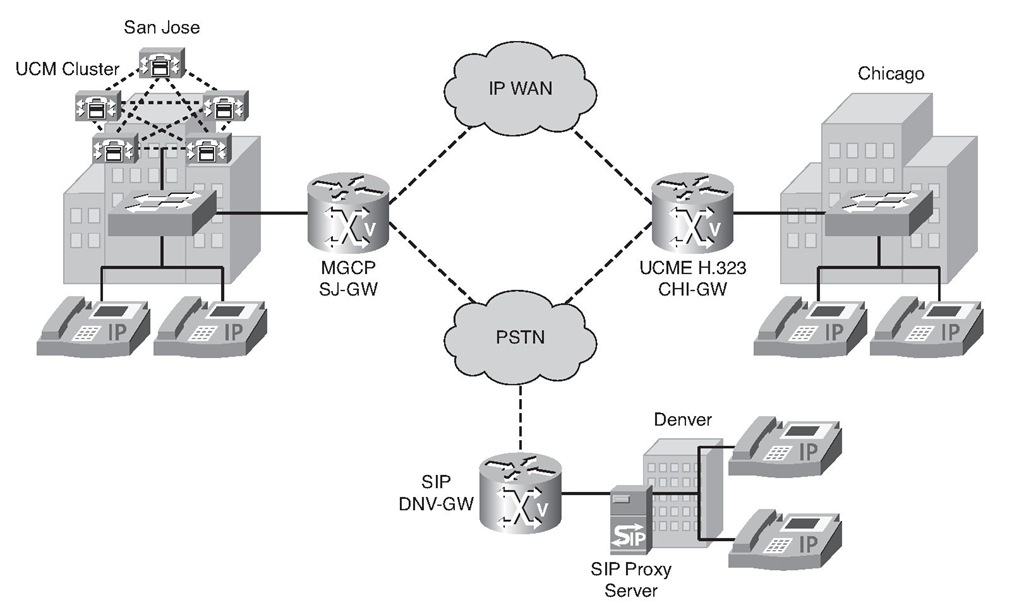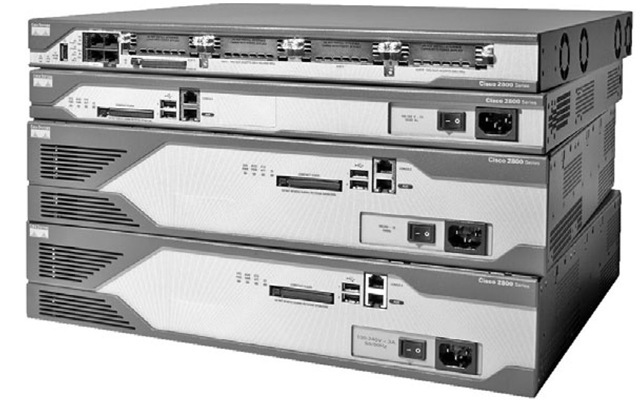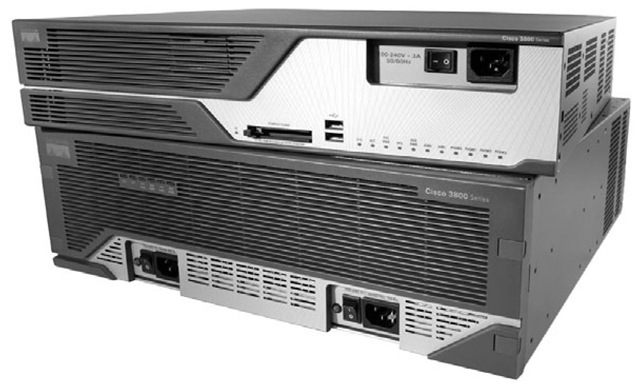Gateways provide a number of ways to connect an IP telephony network to the PSTN, a legacy PBX, key systems, or other TDM systems. Gateways range from specialized, entry-level, and standalone voice gateways to high-end, integrated routers and Cisco IOS gateways. This section introduces voice gateways and deployment models in an IP telephony network.
Understanding Gateways
A voice gateway functions as a translator between different types of networks. Gateways allow terminals of one type, such as H.323, to communicate with terminals of another type, such as a PBX, by converting protocols. Gateways connect a company network to the PSTN, a PBX, or individual analog devices, such as a phone or fax.
Following are the two types of Cisco access gateways:
■ Analog gateways: There are two categories of Cisco analog access systems:
■ Analog station gateways connect an IP telephony network to POTS. They provide FXS ports to connect analog telephones, IVR systems, fax machines, PBX systems, and voice-mail systems.
■ Analog trunk gateways connect an IP telephony network to the PSTN central office (CO) or a PBX. They provide FXO ports for PSTN or PBX access and Ear and Mouth (E&M) ports for analog trunk connection to a legacy PBX. To minimize any answer and disconnect supervision issues, use digital gateways whenever possible. Analog direct-inward-dialing (DID) is also available for PSTN connectivity.
■ Digital gateways: Cisco access digital trunk gateways connect an IP telephony network to the PSTN or to a PBX via digital trunks, such as PRI or BRI common channel signaling (CCS) and T1 or E1 channel associated signaling (CAS). Digital T1 PRI trunks might also connect to certain legacy voice-mail systems.
IP telephony gateways should meet these core feature requirements:
■ Gateway protocol support: Cisco voice gateways support various signaling protocols, depending on the hardware platform. Cisco gateways support H.323, MGCP, SIP, and SCCP. H.323 and SIP gateways do not need a call control agent. Therefore, they can be deployed on networks in which call agents, such as Cisco UCM, are not present. MGCP and SCCP are streamlined protocols that work only on a network in which a call agent, such as Cisco UCM, is present. Cisco IP Phones use SCCP, which is a lighter-weight protocol. SCCP uses a client-server model, whereas H.323 is a peer-to-peer model. MGCP also follows a client-server model.
Note Protocol selection depends on site-specific requirements and the installed base of equipment. For example, many remote branch locations have Cisco 2600XM Series or 3700 Series multiservice routers installed. These routers support H.323 and MGCP 0.1, beginning with Cisco IOS Release 12.2(11)T and Cisco UCM Release 3.1 or later. You might prefer MGCP to H.323 because of simpler configuration. This option also works well with older IOS versions because of support for call survivability during a Cisco UCM failover from a primary to a secondary Cisco UCM server. On the other hand, you might prefer H.323 over MGCP because of the wider selection of interfaces supported.
The Simplified Message Desk Interface (SMDI) is a standard for integrating voice-mail systems with PBXs or Centrex systems. When connecting to a voice-mail system via SMDI and using either analog FXS or digital T1 PRI connections, you will use either the SCCP or MGCP protocol because H.323 devices do not identify the specific line being used from a group of ports. The use of H.323 gateways for this purpose means the Cisco Messaging Interface cannot correctly correlate the SMDI information with the actual port or channel being used for an incoming call.
■ Advanced gateway functionality: The gateways should support the ability to transmit, without corruption, touch-tone digits (that is, Dual Tone Multifrequency [DTMF] tones) and also support a collection of other user services, as follows:
■ DTMF relay capabilities: Each digit dialed with tone dialing is assigned a unique pair of frequencies. Voice compression of these tones with a low bit-rate codec can cause DTMF signal loss or distortion. Therefore, DTMF tones can be separated from the voice bearer stream and sent as signaling indications through the gateway protocol (H.323, SCCP, or MGCP) signaling channel instead.
■ Supplementary services support: These services provide user functions such as hold, transfer, and conferencing, and are considered to be fundamental requirements of any voice installation.
■ Work with redundant Cisco UCM: The gateways must support the capability to "rehome" to a secondary Cisco UCM in the event of a primary Cisco UCM failure.
■ Call survivability in Cisco UCM: The voice gateway preserves the RTP bearer stream (the voice conversation) between two IP endpoints when a Cisco UCM server to which an endpoint is registered is no longer accessible.
■ Q Signaling (QSIG) support: QSIG is becoming the standard for PBX interoperability in Europe and North America. With QSIG, the Cisco voice packet network appears to PBXs as a distributed transit PBX that can establish calls to any PBX or other telephony endpoint served by a Cisco gateway, including non-QSIG endpoints.
■ Fax and modem support: Fax over IP enables interoperability of traditional analog fax machines with IP telephony networks. The fax image is converted from an analog signal and is transmitted as digital data over a packet network.
Gateways are deployed usually as edge devices on a network. Because gateways might interface with both the PSTN and a company WAN, they must have appropriate hardware and utilize an appropriate protocol for that network. Figure 1-9 represents a scenario where three types of gateways are deployed for VoIP and PSTN interconnections.
The scenario shown in Figure 1-9 displays the unified communications network of a company that was recently formed as a result of a merger of three individual companies. In the past, each company had its own strategy in terms of how it connected to the PSTN:
■ The San Jose location used a Cisco UCM environment with a MGCP-controlled unified communications gateway to connect to the PSTN.
Figure 1-9 Gateway Deployment Example
■ The Denver location used a Cisco SIP proxy server and SIP IP phones as well as a SIP-based unified communications gateway to connect to the PSTN. Because the Denver location is only a small office, it does not use the WAN for IP telephony traffic to the other locations. Therefore, Denver’s local VoIP network is connected only to the PSTN.
Modern Gateway Hardware Platforms
This section covers some of the current Cisco voice gateway models used in today’s enterprise environments.
Cisco 2800 Series Integrated Services Routers
The Cisco 2800 Series Integrated Services Routers, as pictured in Figure 1-10, comprise four models (listed from top to bottom): Cisco 2801, Cisco 2811, Cisco 2821, and Cisco 2851. The 2800 Series provides increased security, voice, and overall performance, embedded service options, and dramatically increased slot performance and density, as compared to older 2600 Series models. It also maintains support for most of the more-than-90 modules available for the Cisco 1700 Series Modular Access Routers, 2600 Series Multiservice Platforms, and 3700 Series Multiservice Access Routers.
Figure 1-10 Cisco 2800 Series Integrated Services Routers
The 2800 Series can deliver simultaneous, high-quality, wire-speed services up to multiple T1/E1/xDSL connections. The routers offer embedded encryption acceleration and, on the motherboard, voice digital-signal-processor (DSP) slots. They also offer intrusion prevention system (IPS) and firewall functions, optional integrated call processing and voice-mail support, high-density interfaces for a wide range of wired and wireless connectivity requirements, and sufficient performance and slot density for future network expansion requirements and advanced applications. Go to http://www.cisco.com/go/2800 to learn more about the Cisco 2800 Series routers.
Cisco 3800 Series Integrated Services Routers
The Cisco 3800 Series Integrated Services Routers, as shown in Figure 1-11, also feature embedded security processing, significant performance and memory enhancements, and new high-density interfaces that deliver the performance, availability, and reliability required to scale mission-critical security, IP telephony, business video, network analysis, and web applications in today’s enterprise environments. The 3800 Series routers deliver multiple concurrent services at wire-speed T3/E3 rates.
The integrated services routing architecture of the 3800 Series is based on the 3700 Series. These routers are designed to embed and integrate security and voice processing with advanced wired and wireless services for rapid deployment of new applications, including application layer functions, intelligent network services, and converged communications. The 3800 Series supports the bandwidth requirements for multiple Fast Ethernet interfaces per slot, TDM interconnections, and fully integrated power distribution to modules supporting 802.3af Power over Ethernet (PoE). The Cisco 3800 Series also supports the existing portfolio of Cisco modular interfaces. This accommodates network expansion or changes in technology as new services and applications are deployed. By integrating the functions of multiple separate devices into a single compact unit, the 3800 Series reduces the cost and complexity of managing remote networks.
Figure 1-11 Cisco 3800 Series Integrated Services Routers
New 3800 Series models include the Cisco 3825 Integrated Services Router and the Cisco 3845 Integrated Services Router, available with three optional configurations for AC power, AC power with integrated inline power support, and DC power. Go to http://www.cisco.com/go/3800 to learn more about the 3800 Series routers.
Cisco Catalyst 6500 Series Switches
The Cisco Catalyst 6500 Series Switches, as shown in Figure 1-12, are high-performance and feature-rich platforms that can be used as voice gateways by installing a Cisco Communication Media Module (CMM).
Figure 1-12 Cisco Catalyst 6500 Series Switches
The CMM is a Cisco Catalyst 6500 Series line card that provides flexible and high-density VoIP gateway and media services. A Catalyst 6500 Series Switch can handle multiple digital trunk interfaces. For example, the Cisco Catalyst 6509 Switch supports up to 144 T1/E1 connections by using eight communications media modules with 18 ports each. These gateway and media services allow organizations to connect their existing TDM network to their IP communications network, provide connectivity to the PSTN, and enable conferencing and transcoding services. Go to http://www.cisco.com/go/ catalyst6500 to learn more about the Catalyst 6500 Series Switches.




